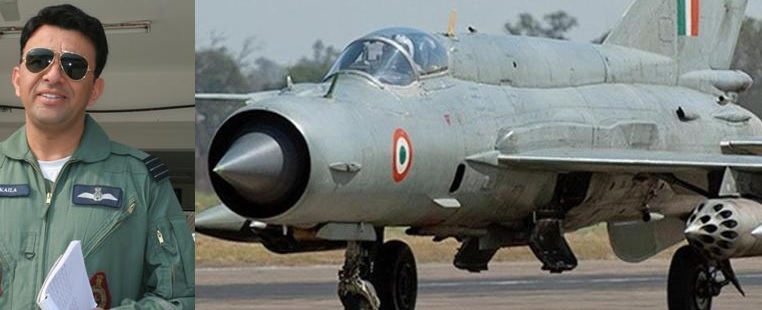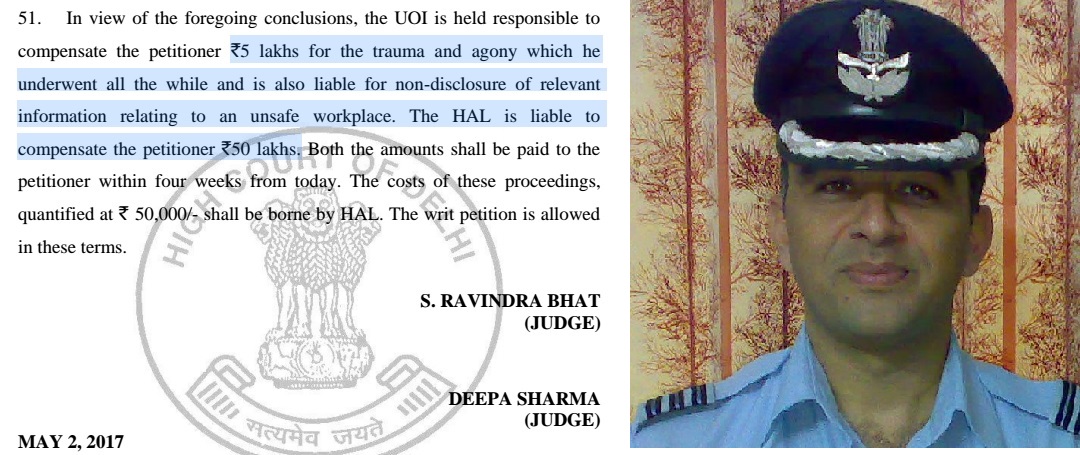
In a verdict that has big implications for the quality of defence manufacture in India, liability of manufacturers, flight safety and accident investigations, an injured Indian Air Force fighter pilot today defeated both Hindustan Aeronautics Ltd (HAL) as well as the Indian Ministry of Defence in the Delhi High Court. The pilot in question is Wing Commander Sanjeet Kaila, a MiG-21 pilot who couldn’t fly again owing to injuries sustained in a 2005 MiG-21 crash — an accident in which he stayed inside the doomed aircraft till the last moment in order to save a village on the ground. Here the operative part of the landmark judgement:

The pilot’s court victory is significant for more than one reason. Apart from fixing accountability on HAL for the MiG-21 accident, Livefist has learnt the Delhi High Court has imposed costs on both HAL and the government. The case was filed by the officer against both in 2013 after he discovered that it was a manufacturing defect by HAL that contributed to the near fatal accident. The Indian Ministry of Defence, helmed at the time A.K. Antony had accused the pilot of hunting for compensation though Kaila and his lawyers had repeatedly informed the Delhi High Court that he was looking for accountability to be fixed, not monetary compensation.
https://www.youtube.com/watch?v=TuMFt4PE550
Justices S Ravindra Bhat and Deepa Sharma ruled in the pilot’s favour, saying he had been operating in an environment with ‘more risk’ than he had bargained for. The verdict was based on Kaila’s case against the government on charges that the defect-spurred accident was a violation of his fundamental right to life, especially the right to work in a safe environment, enshrined in Article 21 of the Constitution of India.
Your correspondent reported in India Today in 2014 on the details of the 4 January 2005 incident where it all began:
Wing Commander Kaila, then a Squadron Leader at the IAF’s frontline fighter base in Nal, Rajasthan, took off on a regular flight exercise in a MiG-21 (Tail No. C-2236) as part of daily flying duties. His aircraft jerked dangerously to one side immediately after take-off. Over radio, he was informed by his wingman in a MiG-21 flying near him that his aircraft’s tail was on fire. According to his petition, and thereafter recorded in official communications within his unit, “Despite a near-complete engine/control failure and at grave risk to his own life, Kaila continued to stay put in an almost uncontrollable aircraft so as to steer it away to safety from a nearby village. To save human life, he ejected only seconds before the crash of the aircraft.” Despite the crash, Wing Commander Kaila continued to fly fighters for nine months after the accident, but was then forces to stop after his condition in his spine abruptly deteriorated. A Court of Inquiry into the crash revealed that the chief caused of the accident was a fatigue crack in the welded portion of the after burner manifold leading to a fire in the aircraft — the structural weakness of the safety-critical component was attributed by the IAF to to a manufacturing defect and poor workmanship at the HAL’s MiG-21 license production facility.
Wing Commander Kaila, now posted in Nashik, spoke to Livefist shortly after the court verdict today, saying, “It’s been years-long fight and I feel vindicated. I hope this has the necessary implications for defence industry and responsibility.”
The implications of financial liability on manufacturers could be significant and the case appears to set a clear precedent. It also seems fairly clear that industry will need to look closely at the judgement. Livefist is awaiting a copy of the court judgement and will update this post with details.

How a “fatigue crack” can be blamed on the manufacturer, its is caused by fatigue and can be blamed only on the decision to fly the old aircraft.
There is a time limit for fatigue crack if it occured in an aircraft certified airworthy then they are to be blamed
Fatigue should not cause a crack unless the part is beyond life expectancy. If it does, the manufacturer is liable, in this case for poor welding. Everyone knows HAL has quality issues but they cannot escape anymore. Excellent outcome not just for pilot and IAF but for India.
Fatigue crack will be recognized as such only and only if the part/assembly fails within the stipulated life span. The life span is decided by the HAL/mfrr, and the part needs to be replaced before expiry of the life span which is the primary duty of HAL. What HAL does is to ‘extend the life’ of the part to escape replacing the part to save time/money/effort as it may need an import/mfg time. As regards to the decision to fly the a/c, the a/c is flown only when HAL certifies it as ‘fit to fly’. Please reconcile.
When ever an aircraft is offered for flying , the the ground engineer of the company or service provider (HAL) certifies fitness of the aircraft to fly safely then only Pilot takes the aircraft for flying. HAL Engineer certified the faulty aircraft as fit to fly so held responsible
The after burner manifolds are ‘rotables’ and are released for use as individual items after overhaul and testing. If I am not mistaken, these items are changed sometimes in BRDs as a part of routine maintenance.
Excellent reply Chilaram. A host of pilots of the IAF today lie injured because of such defects which are regularly traced back to the HAL. I can narrate a host of such incidents.
Wonderful development. Maybe atleast now agencies like HAL, ADA and DRDO will realise the importance of quality
The IAF should list all accidents which their Inquiries have confirmed to be due to manufacturing defects. This will give possible outstanding relief to scores of NOK!!!!!!
HAL = Hai Asli Laudo
‘HAL’ and ‘GOVERNMENT’ become responsible and shall make financial compensation as per court verdict and matter will rest there .Responsibility of these items replacement or manufacturing or extending the limits and accepting the quality should be fixed on the individuals taking decisions .
Sad that the pilot had to fight the case. Why is the Airforce a silent spectator. They should strongly put it accross to the Defence Ministry.
HAL should be held accountable and must pay out without appeal. Their products like twin engine heptr qty two have had accidents in last 3 months – Dhruv. All others grounded. HAL needs a hard drive on its back side.